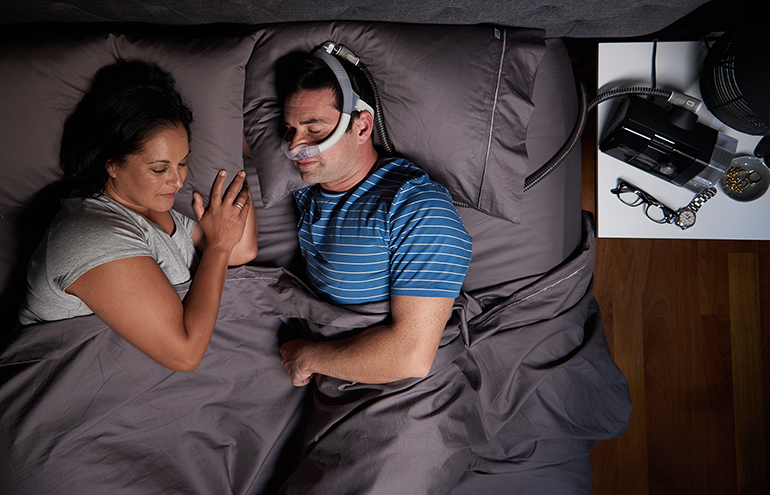Do you snore and wake up not feeling rested despite a full night’s sleep? Do you experience morning headaches and excessive daytime sleepiness? If so, you are probably suffering from obstructive sleep apnea syndrome (OSAS)!
OSAS is a common pathology (3-7% of the general population). It negatively impacts quality of life and increases the risk of developing cardiovascular diseases. An overnight respiratory polygraphy is required to establish a diagnosis. Depending on its severity and characteristics, several treatments can be prescribed, but CPAP (Continuous Positive Airway Pressure) therapy is the most effective.
What are the symptoms?
OSAS is characterized by episodes of apnea (pauses in breathing lasting at least 10 seconds) or hypopnea (reduced respiratory flow associated with a reduction in blood oxygen levels) during sleep that are caused by total or partial obstruction of the upper airways and are associated with daytime sleepiness.
Being overweight is the major predisposing factor for OSAS, but people of normal weight can also be affected. A vast majority of people with OSAS snore but, thankfully, the opposite is most often not the case. Many other manifestations can occur during sleep: feeling of choking, night sweats, and frequently waking up to urinate are common.
OSAS is responsible for poor sleep quality that can result in restless sleep, morning headaches, memory and concentration problems, irritability, depression, and reduced sex drive, but the most frequent manifestation is daytime sleepiness, which can be particularly invalidating.
What are the health consequences?
In addition to the symptoms mentioned above, untreated OSAS is responsible for cardiovascular problems. It increases the risk of developing arterial hypertension and can cause pre-existing hypertension to be poorly controlled. It also increases the risk of cardiac arrhythmias, heart attacks, heart failure, and strokes.
When should I see a specialist?
OSAS should be suspected and investigated in the presence of evocative symptoms (see above), poorly controlled arterial hypertension, or evident cardiovascular or cerebrovascular diseases. Sometimes, the patient may not feel any of the usual symptoms. Fortunately, his or her partner can often notice loud snoring with pauses in breathing.
An overnight polygraphy prescribed by a respiratory physician is necessary to confirm the diagnosis. This exam is conducted at home, where the patient is fitted with oxygen saturation and heart rate sensors, nasal airflow sensor, and abdominal and thoracic belts (to analyze breathing movements) (figure 1).
How is it treated?
Treatment depends on severity (number of apneas and hypopneas per hour), patient’s cardiovascular risk factors, and the degree of daytime sleepiness.
For mild to moderate cases, mandibular advancement devices can be proposed. These made-to-measure gumshields pull on the jaw to widen the opening of upper airways. However, they do not work on every patient and when they do, only reduce the number of apneas/hypopneas by half on average. Furthermore, they have not been proven to lower cardiovascular risk.
The treatment of choice for OSAS is a CPAP device that provides continuous positive air pressure, thus preventing the upper airways from collapsing. The pulmonologist will chose the mask that will fit the best to each patient (figure 2). When used regularly and adjusted properly, CPAP corrects OSAS completely. In the past, these devices tended to be uncomfortable, but they are now silent and patients generally get used to them easily.








